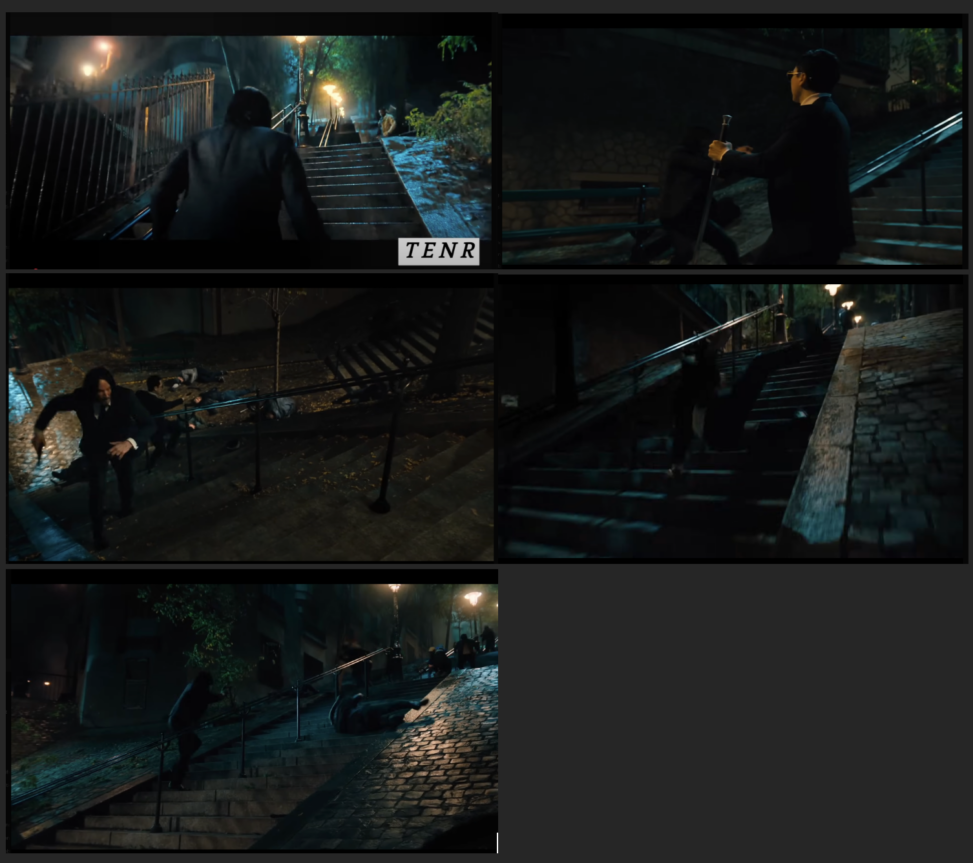John Wick: Chapter 4 (2023) is the pinnacle of stylish, action-packed films. With its recurring themes of tenacity and battle, the “Staircase Fight Scene” is perhaps the most terrifying action sequence in the movie. Through this deconstruction, I will analyze the following frames from the scene with a critical assessment of their significance, composition, and thematic relevance and contrast them with scholarly analysis and the broader implications of such constructions of violence in media.
The ‘Staircase Fight Scene’ is a definitive example of the relentless willpower and icy cruelness of the world of John Wick. The scene begins as John stands at the bottom of the seemingly bottomless staircase. This moment, as illustrated by Screenshot 1, visually captures the gargantuan battle that awaits. The low-key lighting, and ambient tone, coupled with the top-down view, visually illustrate the fight uphill which John is presented with. The mise en scène of the setting, the lampposts and the iron railing create a gritty, nigh mythic mood, defining John as a lone warrior embarking on a challenging journey. As the camera moves inexorably closer to John’s resolute face, the staircase, as a physical impediment, represents his ongoing pursuit of freedom and redemption.
As John ascends the stairs, he encounters lots of enemies, and this produces frantic and non-stop battles. Screenshot 3 captures one such frenzied in-progress fight scene as John is battle-hardened and fighting his foes. The movement of the active camera and speedy cuts produce a sense of franticness, whereas the close-up shot adds a visceral impact to each punch. The cutting proceeds smoothly from shooting to hand-to-hand combat in accordance with the relentless fighting stance of John. The choreography here is very precise, pairing brutality with grace, something which has been a signature of the John Wick franchise. Close camera cuts and close framing place spectators in the middle of the frantic rhythm of the battle. As Smith (2023) has suggested, contemporary action cinema makes it difficult to distinguish between violence as spectacle and violence as narrative, and tension is at its most explicit in this sequence.
Conversely, Screenshot 4 depicts John’s vulnerability after he is pushed down the entire staircase with raw force. With John slipping into the stone stairs, the scene highlights his vulnerability but at the same time insists on him as a determined and fighting person. The illumination used in this photo, which was darker and overshadowed, emphasizes the moment of defeat in direct contrast to his struggle upward in the preceding photographs. This is an effective reminder of the physical and psychological price of violence to the protagonist. Following Lee (2024), the depiction of physical exhaustion and suffering in action films not only lends realism to the film but also makes the otherwise superhuman hero more human, so that the viewer can understand his predicament.
The final chosen frame, Screenshot 15, captures John Wick and his ally standing shoulder to shoulder at the stairs’ top. The symmetrical composition, with the lamppost in the center, symbolizes their hard-won victory and the worth of a helper breaking through adversity. The upward light is symbolic of victory and toughness and contrasts with the previous dark shots. This photographic transition from light to dark serves as a symbol of John’s constant pursuit of redemption. This slightly broader shot allows the viewers to see both characters fully, emphasizing their team and collective victory. These instances are of great importance within action films, contends Brown (2025), for they reflect the shift in the development of the hero from a loner warrior into someone who can also work alongside other people.
John Wick: Chapter 4 was a box office hit in a runaway capacity, raking in over $400 million at the international level. The film has been hailed for its grand cinematography but also faulted for possibly causing desensitization in spectators through its demonstration of brutality. As much as it is elegant to watch, extremely stylized violence also holds the potential for further normalizing violent action, especially in youths, as specified by Green (2024). However, some researchers theorize that the hyper-real quality of such scenes, as those found in the John Wick franchise, gives a clear demarcation between screen fantasy and real violence to allow audiences to appreciate the choreography without necessarily condoning the shown brutality.
The Staircase Fight Scene from John Wick: Chapter 4 is a lesson on how to combine action, narrative, and visual storytelling. The screenshots chosen are the sum of what the scene is: struggle, persistence, and duality of violence as an internal and cinematic experience. Through close reading and a scholarly approach, it is possible to get that the effect of the film transcends the mere enjoyment factor because it prompts us to consider violence and representation of violence in media. In this scene, we come to see more clearly how action films of today utilize choreography, cinematography, and themes to compose exciting stories that resonate with the hearts of movie viewers all over the world.
Bibliography
Brody, Richard. “‘John Wick: Chapter 4,’ Reviewed: A Slog with a Sensational Ending.” The New Yorker, March 21, 2023. https://www.newyorker.com/culture/the-front-row/john-wick-chapter-4-reviewed-a-slog-with-a-sensational-ending.
Scheck, Frank. “‘John Wick: Chapter 4’ Review: Latest Entry in Keanu Reeves Franchise Is Pure, Over-the-Top Action Spectacle.” The Hollywood Reporter, March 13, 2023. https://www.hollywoodreporter.com/movies/movie-reviews/john-wick-chapter-4-review-keanu-reeves-1235351676/.
“John Wick: Chapter 4.” Box Office Mojo. Accessed April 4, 2025. https://www.boxofficemojo.com/title/tt10366206/.
“John Wick: Chapter 4.” Wikipedia: The Free Encyclopedia. Wikimedia Foundation, last modified April 4, 2025. https://en.wikipedia.org/wiki/John_Wick:_Chapter_4.


Crispin Friskie
I find John Wick Chapter 4 puts a lot of attention to detail in their set pieces and chosen camera angles as stated here, especially with always making sure that the viewer feels like their in the middle of the action or at least that John Wick is in the center of the action even throughout the frantic movement, specifically in the case of the staircase scene, the movement of the actors and the constant action are well outlined through how it feels in each provided cut. The images provided show off all of the scenes being discussed by not only showing the angle the camera is placed at but also how things like lighting effect the scene, even with that the angles alone are again used to keep the viewer in the middle of the action. Sources are cited effectively to emphasize certain details observable in each scene specifically about certain details relating to the violence and the physical exertion of the protagonist, a detail that can often feel a bit overlooked. Overall I find this description of the use of Mise en Scene of one of the most unique scenes in the film to be a interesting and deep look at what makes this scene such a standout in such a action heavy film.